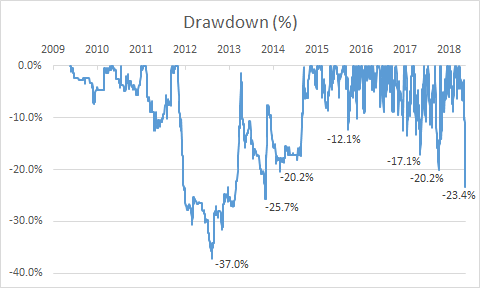I have great respect for the credibility of the Stockrank system and it is not a coincidence that >70% of my holdings have a SR>80. However, my single biggest holding Burford Capital (LON:BUR) is notably different with the lowest SR of all - Just 45. Worse it is classified as a “Momentum Trap” because of its strong M (100) and low Q (36) and V (14) scores. Yet it has been my best preforming company by a mile.
It’s not only the SR that take a cautious view of BUR because broker forecasts have repeatedly underestimated Burford Capital (LON:BUR) earning potential. Today’s H1 earnings announcement has again surprised to the upside and the house broker has upgraded its full year EPS by +74%, adding that they are unsure how to value the company.
This strengthens my view that it is important to look at a company as a whole and consider news, growth potential and its metrics. As ever please DYOR. Ian
I just cannot recommend reading the Burford results enough: they really do go to great effort to explain how they value claims. The last interims are here: http://www.burfordcapital.com/wp-content/uploads/2018/07/BUR-30307-Interim-Report-2018-web.pdf
But I would particularly highlight the section I have cut and pasted below, the key point of which is that although unrealised gains are included in the accounts, they are done so very conservatively, so that, historically, a case has only been valued in the 12 months before it concludes, at 35% of its eventual worth. In other words, there seems little reason to believe that unrealised gains are overstated (quite the opposite) or that the rate of profits that BUR is likely to slow at any time in the future: indeed, as the volume of claims invested in grows (and has grown close to exponentially) it is reasonable to expect, 3-4 years later, that profit will follow a similar curve.
Quote from interims:
Of course, new business is only as good as the
profit it ultimately generates, and the first half was
particularly strong with regards to both income
and cash generation from invested capital.
We generated almost $200 million in income from
litigation investments in the period, a 21% increase
from 2017. Of that income, 62% is composed of
realised gains and only 38% of unrealised gains.
The relative composition of our income will ebb
and flow with case activity, but it is noteworthy that
the proportion of unrealised gain in our income
was considerably lower than it was in either fiscal
2017 or fiscal 2016. We attach no importance to
that change or indeed to the proportion in the first
place, as we discuss at length at page 22 of our
2017 annual report, but we point it out here given
that we are often asked about it.
To shed more light on the question of valuation
and unrealised gain, we have prepared the
graphic to the right. This shows the timing and
quantum of valuation changes over the life of
litigation investments. The chart looks at our total
profit from all of our fully- and partially-concluded
investments to date and shows what portion of
that profit was already recognised in each year
prior to investment conclusion, and demonstrates
that when we do recognise unrealised gains, most
of them occur close to investment conclusion.
So, across our total portfolio, only 7% of our
ultimate investment profit was ever recognised in
investments three years prior to their conclusion,
rising to 12% two years prior to conclusion and to
35% one year prior to conclusion. Notably, 65% of
our investment profit has never been taken before
investment conclusion. As we noted in our annual
report, it is rare for investments to swing to a loss
after incurring a write-up.
Important as financial statement measurements
are, at the end of the day we focus more than
anything else on bringing cash in the door. On
that metric, the first half was very successful. We
generated $288 million in cash in the period from
our litigation investments, a significant increase
from $172 million last year and $91 million in 2016.
Indeed, Burford has generated well over a billion
dollars in cash in our short life, validating the
investment model we use.












